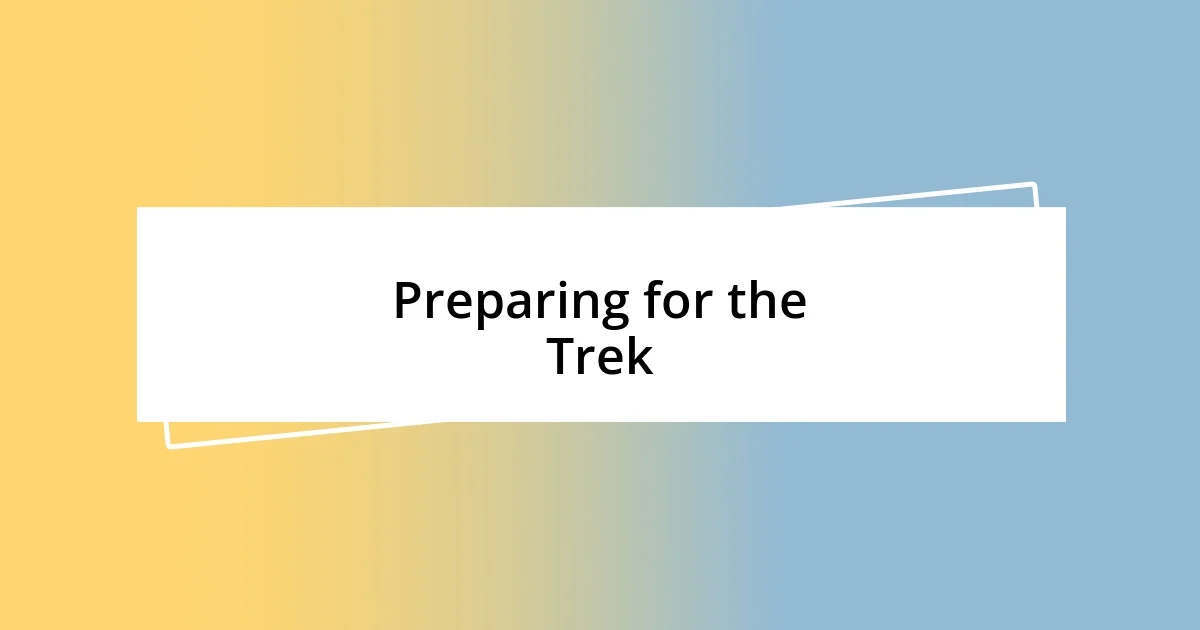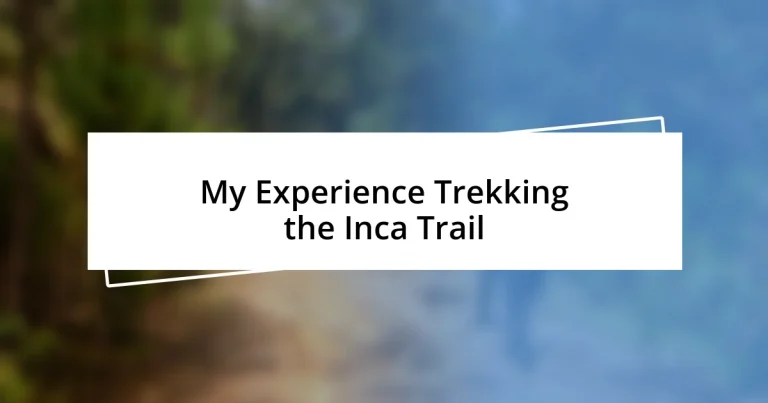Key takeaways:
- Preparation is crucial for the Inca Trail; a checklist of essential gear enhances comfort and hydration, ensuring an enjoyable experience.
- Each day of the trek presents unique challenges and opportunities for bonding with fellow trekkers, fostering a sense of community.
- Reflection on personal growth and the importance of patience are vital lessons learned throughout the journey, emphasizing the value of shared experiences.

Overview of the Inca Trail
The Inca Trail is a breathtaking trek that spans approximately 26 miles, leading adventurers through diverse landscapes from lush jungles to stunning mountainous terrain. Each step feels like a journey through history, as you walk the same paths that the ancient Incas used to connect their sacred sites. Can you imagine the stories these trails could tell if they could speak?
As I made my way along the trail, I encountered remnants of Incan architecture, such as the impressive stone ruins at Wiñay Wayna. Standing there, enveloped in the misty air and vibrant greenery, I couldn’t help but feel a deep connection to the past. It’s moments like these that transform a simple trek into a spiritual experience, making you question your own place in the vast tapestry of history.
The trek is not just about reaching Machu Picchu; it’s about the journey itself and the challenges it presents. I remember struggling during the steep ascents, yet those physical challenges infused my experience with a sense of accomplishment that I’ll never forget. Isn’t it fascinating how difficulties can lead to the most rewarding moments? Each bend in the trail revealed staggering views that made every drop of sweat worth it.

Preparing for the Trek
Preparing for the trek requires careful planning and a spirit of adventure. I’ll never forget the excitement mixed with a bit of anxiety as I packed my bag for the first time. I wanted to ensure I had everything I needed without overpacking. It’s definitely a balancing act! I learned that being comfortable during the trek is just as important as having the right gear.
Here’s a checklist of essentials to consider for your Inca Trail adventure:
– Good quality hiking boots: Make sure they are broken in but not worn out.
– Daypack: Something light but spacious enough to carry your water and snacks.
– Clothing layers: The weather can change rapidly, so dress in layers.
– Hydration system: Staying hydrated is crucial during the trek.
– Lightweight rain gear: A reliable poncho or jacket can save the day.
– Sunscreen and a hat: Protect your skin and keep cool under the sun.
– Snacks: Energy bars or trail mix for those quick energy boosts.
– Personal medications: Always wise to carry any essentials you might need.
Taking the time to prepare thoroughly not only eases the physical journey but also enhances your mental readiness. I found that during the trek, knowing I had everything I needed made it easier to focus on the beauty around me rather than the discomfort of being unprepared. That tranquility in the face of nature’s grandeur is a gift in itself.

Essential Gear for Trekking
As I prepared for my trek, I realized the importance of lightweight gear. Opting for a compact, waterproof jacket was a game changer for me. On day two, when the clouds rolled in, I was grateful for its convenience. It kept me dry and comfortable without weighing me down while I navigated the steep paths. Packing light made the uphill struggles feel just a bit easier, allowing me to enjoy the stunning views instead of getting bogged down by my load.
I also discovered the necessity of investing in a good pair of trekking poles. When I first started using them, I felt a mix of skepticism and curiosity. After a few hours on the trail, however, they became my best friends. They provided stability on precarious descents, taking the pressure off my knees, which made my steps feel more secure. I can’t stress enough how much of a difference the right gear can make in your trekking experience.
Finally, don’t underestimate the power of hydration. I carried a lightweight hydration bladder, which made sipping water on the go effortless. There were moments, especially at high altitudes, when I felt dizzy and fatigued; quick access to water made a huge difference in my energy levels. Staying hydrated not only kept my body functioning well but also helped me savor every moment, from the high-altitude landscapes to the company of my fellow trekkers.
| Essential Gear | Importance |
|---|---|
| Good quality hiking boots | Provide comfort and ankle support |
| Daypack | Ensures you carry your essentials without extra weight |
| Clothing layers | Adapts to changing weather |
| Hydration system | Keeps you hydrated throughout the trek |
| Lightweight rain gear | Protects you from unexpected downpours |
| Sunscreen and a hat | Prevents sunburn and heat exhaustion |
| Snacks | Provides quick energy boosts |
| Personal medications | Ensures you’re prepared for any health needs |

Daily Itinerary and Highlights
Every day on the Inca Trail unfolded like a chapter of a thrilling story, each with its own unique highlights. I vividly recall Day 1, which started with a brisk morning as we left the trailhead, the anticipation palpable in the air. Walking through lush valleys surrounded by vibrant greenery, I sometimes caught myself pausing, captivated by the beauty. Did you ever experience that moment when the world seems to stand still? For me, those beautiful landscapes were a reminder of how present I needed to be in the experience.
As we reached the first campsite on Day 2, I was overwhelmed by the sense of community that developed among trekkers. Sharing hearty meals under the stars created bonds I hadn’t expected. The camaraderie was infectious, and honestly, I wonder how many friendships are born on trails like these? It was on that night, huddled around the campfire, that I truly felt the value of shared experiences, as laughter and stories wrapped around us like the warmth of the fire.
Day 3 pushed our limits, both physically and mentally. I still remember the steep ascent to Dead Woman’s Pass, my legs shaking with every step. Yet, when I finally reached the summit, it was like summiting a mountain in my mind as much as in reality. The view was beyond breathtaking, and the sense of accomplishment washed over me like a wave. You can’t help but feel that life is about those moments of triumph, right? I could see the trails winding into the horizon, whispering tales of the ancient Incan civilization, and I felt incredibly small yet inexplicably connected to something greater.

Tips for a Successful Experience
To ensure a successful trek on the Inca Trail, one of the best pieces of advice I can provide is to practice good pacing. It’s tempting to push yourself to keep up with the faster group members, but I found that listening to my body was more important. I often reminded myself that this journey is a marathon, not a sprint. After all, each step brings you closer to the breathtaking final destination, so why not take the time to savor the scenery along the way?
Another essential aspect is to stay connected with your fellow trekkers. I remember my first night on the trail when we gathered around the campfire. Sharing stories and laughter not only lightened the mood but also created a sense of unity. Those conversations kept my spirits high during the toughest stretches. Have you ever felt that close bond form over shared struggles? Trust me, it turns a taxing journey into an unforgettable adventure.
Lastly, don’t forget to embrace the unexpected. I’ll never forget when a sudden rain shower hit us on day three. At first, I was frustrated, but then I stopped to look around. The rain transformed the landscape into a lush paradise, and I realized I’d miss that vibrant beauty if I wished it away. Allowing flexibility on the trail can turn challenges into opportunities for discovery. How many times have you stumbled upon a hidden gem because you were open to change?

Dealing with Altitude Sickness
Altitude sickness can hit unexpectedly, and I can tell you from my own experience, being aware of the signs is crucial. I first felt the subtle onset when my head began to throb on the second day. It’s an unsettling feeling, like you’re caught in a fog while everyone else seems to dance through the air. Recognizing these warning signs early can mean the difference between powering through or needing to take a step back and rest.
Hydration is key, as I learned during my trek. I made it a habit to drink water like it was a sacred ritual, refilling my bottle at every opportunity. It was surprising how much a simple sip could clear the heaviness in my head and lift my spirits. Have you ever felt the weight of a difficult climb ease with every gulp of fresh water? Trust me, staying hydrated not only helps combat altitude sickness but can transform your entire trekking experience.
Another effective strategy was taking frequent breaks, especially during steep ascents. I remember hunkering down during a particularly tough stretch, just breathing and soaking in the incredible views. Those pauses allowed me to recharge physically and mentally. Occasionally, I’d chat with fellow trekkers about our shared struggle, and that sense of community made the discomfort feel less daunting. How do you cope when faced with challenges? For me, surrounding myself with supportive companions turned what could have been a solitary battle into a shared adventure full of encouragement.

Reflections After the Trek
Reflecting on my trek, I can’t help but marvel at how much I learned about myself. The days spent hiking through breathtaking landscapes pushed my physical limits, but it was the quiet moments that truly resonated. I once stood atop a ridge, feeling the crisp air against my skin, and couldn’t help but ask myself, “What have I gained from this experience?” Each step forward became a metaphor for life’s journey—navigating through struggles and enjoying the rewards.
I also realized the importance of patience. There were times while trudging uphill that frustration bubbled beneath the surface. Yet, in those moments of vulnerability, I often paused to take in my surroundings, which helped me to reframe my mindset. Have you ever noticed how simply taking a deep breath can transform your perspective? Finding joy in the journey, rather than fixating on the destination, revealed the beauty of the Inca Trail in vivid detail.
Lastly, the trek forged deep connections that I never anticipated. One night, under a canopy of stars, I shared heartfelt stories with my fellow trekkers, sparking a camaraderie that I now hold dear. Reflecting on those late-night conversations, I realize how shared experiences can create bonds that extend beyond our time on the trail. Isn’t it fascinating how a common goal can bring us together? Those relationships became as invaluable as the sights we encountered, teaching me that our adventures are often about the people we meet along the way.














